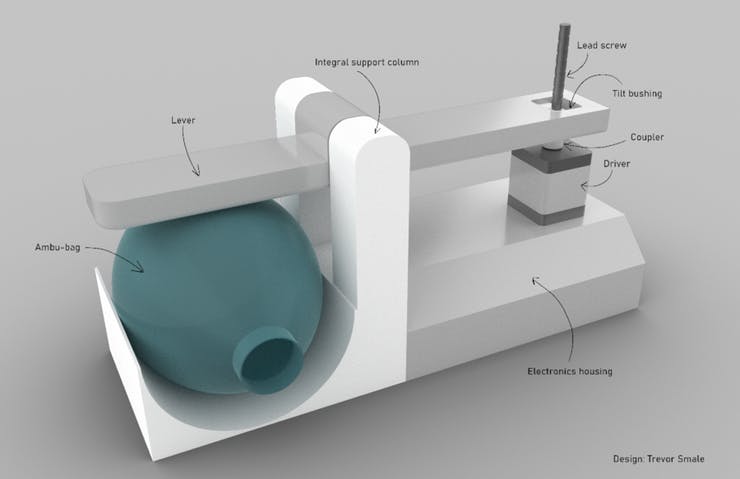OpenLung, un ventilator open-source pentru combaterea COVID-19
+ Add to Google News
- Hardware
- ro
- FlorinM
- 5 years ago
- 2020-05-02 07:50:00
- comments
- : 4 minute 5 secunde
- image: OpenLung
Un grup de voluntari au creat designul unui ventilator cu sursa deschisa care poate fi fabricat intr-o perioada scurta folosind piese economice. Se numeste proiectul OpenLung, care combina si foloseste expertiza din intreaga lume pentru a veni cu un design care poate fi produs in masa folosind componente certificate.
Ventilatorul medical de urgenta OpenLung (OEMV) este o solutie pentru deficitul global de ventilatoare medicale. Dezvoltarea sa rapida este rezultatul unei noi paradigme open source care permite membrilor echipei sa contribuie in timp real din orice loc al lumii. Dispozitivul in sine este compus din materiale disponibile pe scara larga si asamblate prin procese simple de fabricatie. Componente electrice si software au fost de asemenea dezvoltate, acestea permit stabilirea parametrilor de baza si a controalelor de catre clinicieni. Au fost construite prototipuri fizice si testarea catre un produs final este in curs de desfasurare. OEMV este o tehnologie deschisa care poate fi fabricata si implementata oriunde in lume.
Plamânii afectati de COVID-19, in cazuri acute, nu sunt capabili sa inspire si sa expire normal aerul. Un ventilator este proiectat in principal pentru a furniza oxigen pentru plamâni. Acesta face acest lucru prin pomparea mecanica a oxigenului in plamâni printr-un tub care iti intra gura. Un ventilator poate fi programat pentru a „respira” in interior si in exterior pentru un pacient sever afectat, furnizând astfel oxigen acestui flux sanguin. Acest lucru cumpara ceva timp pentru ca pacientul sa se recupereze de boala si pentru ca plamânii sa se vindece de deteriorarea cauzata de virus. Din cauza rolului in salvare a vietii pe care ventilatoarele il joaca in spitalizarile de COVID-19, spitalele din intreaga lume se "bat" pentru a pune mâna pe ventilatoare pentru a salva cât mai multe persoane. Lumea nu a vazut niciodata o pandemie de aceste proportii de la gripa spaniola din 1918. Spitalele noastre nu au tratat niciodata atât de multi pacienti cu boli respiratorii.

Open Statement
There is a massive shortfall of medical ventilators throughout both the developed and developing world. Even with the promise of a vastly increased production capacity on the horizon; projected demand will not be met. In short, there is desperate need for an immediate stopgap solution. With this in mind the retrofitting of readily available devices via the development of cost-effective components—these things brought together via an easily replicated fabrication process—is beyond promising.
The MIT Emergency Ventilator (E-Vent) Project has inspired our own initiatives and provided firm guidance regarding technical specifications and quality control. By using online based DevOps tools (e.g. GitLab) we have been able to work around the clock and coordinate the efforts of qualified people from all over the world. Although our project is an open sourced initiative, all final efforts are rigorously overseen by a dedicated team of both medical and engineering professionals. Our aim is to set as many capable minds as possible toward a common goal—the development and subsequent deployment of a functional medical device to aid in the recovery of those afflicted with COVID-19.
Our focus developed along the line of retrofitting parts that are easily manufactured and maintain a high degree of standing availability (e.g. manual resuscitators). We drew inspiration from their rudimentary design but developed attributes that would use more robust, but also readily available, materials. Most of the components in our finalised design are novel, but we've made sure that the materials from which they are manufactured are common and widely available through numerous supply chains. If suggested materials should become scarce or unavailable—in a given country or region—there are alternative materials that may be used (we've accounted for this within our design). Further, all components are easily manufactured via common methods (i.e. CNC/Laser/Water Jet Cutting, High Volume Stamping, etc.). The OpenLung Emergency Medical Ventilator may be built using near at hand materials through simple fabrication processes.
The electrical hardware of the OpenLung consists of components that are as accessible as the materials which comprise its mechanical components. Software has been developed for the manual operation of standard controls (i.e. Respiratory Rate, Inspiratory/Expiration Ration, Tidal Volume) and to provide real-time readouts (i.e. Peek, Plateau, and Positive End-Expiratory Pressure). Also, an automated alarm system has been incorporated and will alert nearby clinician(s) should hardware fail or control adjustments need be made. Both mechanical and non-mechanical aspects of OpenLung have moved beyond proof-of-principle and into active physical trials.
Due to OpenLung's unique open source development process we've been able to progress through numerous paper-prototype iterations with great rapidity; this accelerated pace has allowed us to move from drawing board to physical model in only two short weeks. The ongoing testing of working prototypes has helped us improve upon and simplify mechanical components as results are fed back into the OpenLung community for group driven analysis. We are rapidly advancing toward a finalised model.
OpenLung's open source development paradigm has unleashed the creative potential and technological knowhow of hundreds of people across the world. Their collective efforts have been harnessed and driven toward the completion of a medical device that is easily built and available for widespread use. As the COVID-19 pandemic escalates so too does necessity of having essential equipment available to medical professionals. The rapid development and deployment of the OpenLung Emergency Medical Ventilator provides a solution that will surely save lives.
- powered by Verysign














